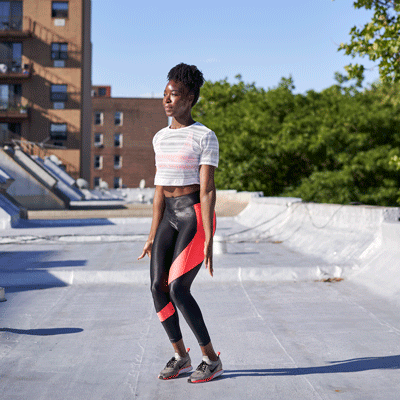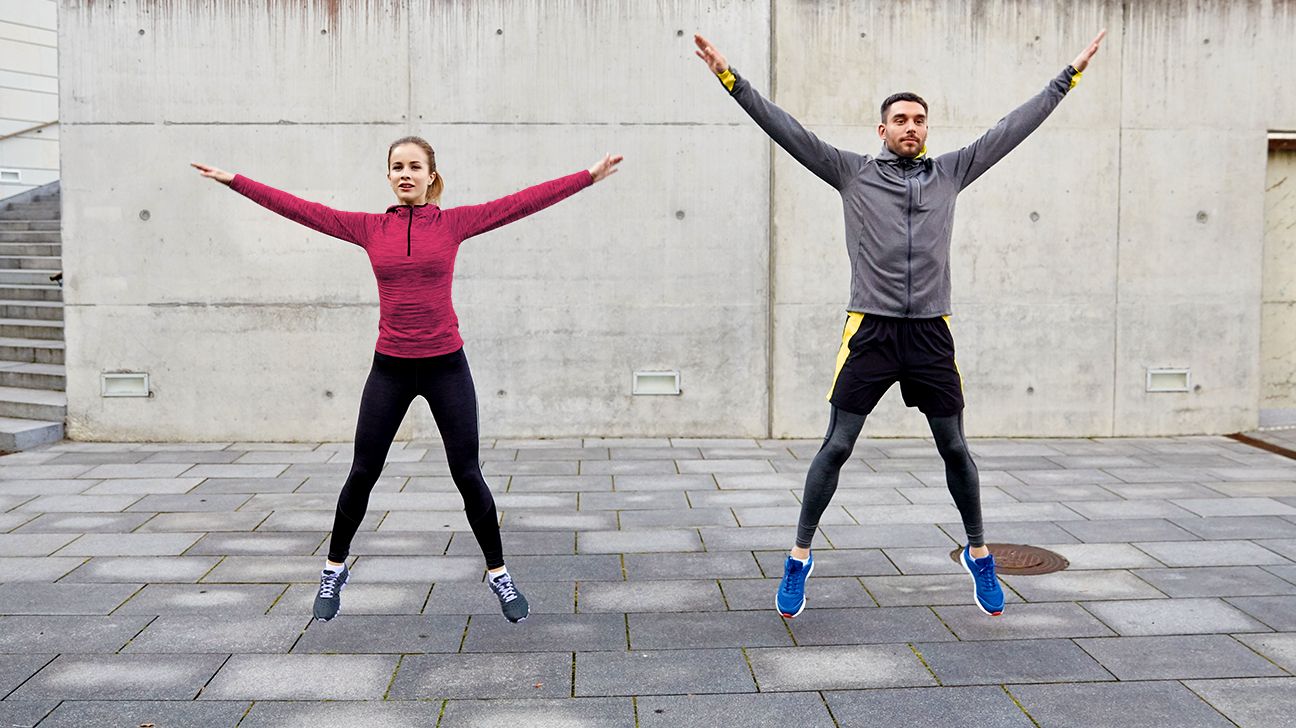We include products we think are useful for our readers. If you buy through links on this page, we may earn a small commission. Here’s our process.
Greatist only shows you brands and products that we stand behind.
Our team thoroughly researches and evaluates the recommendations we make on our site. To establish that the product manufacturers addressed safety and efficacy standards, we:- Evaluate ingredients and composition: Do they have the potential to cause harm?
- Fact-check all health claims: Do they align with the current body of scientific evidence?
- Assess the brand: Does it operate with integrity and adhere to industry best practices?
While no grade school PE class would be complete without at least one set of jumping jacks, when was the last time you actually did them? If you haven’t thought about them since, say, you stopped faking sick to get out of gym, you’re not alone.
But this classic calisthenics move is worth bringing back — especially when you’re short on time or don’t have access to a full gym. You’ll work your entire body and get your heart pumping.
For someone who weighs 150 pounds, doing vigorous jumping jacks for just 1 minute could burn 9 calories. That’s about 50 jacks. In 10 minutes, you could do 500 jumping jacks and burn 90 calories!
No need to jump for 10 minutes straight. Feel free to split them up throughout the day.
“Jumping jacks fall into the category of exercises most people assume are extremely simple so don’t require any attention to technique,” says New Jersey personal trainer Nick Occhipinti. Calisthenics do require some attention to detail so they can be performed effectively and safely.”
Here’s how to earn a gold star for perfect form when doing jumping jacks.

- Stand up straight with your arms at your sides.
- Jump up as you spread your feet wider than your hips and bring your arms overhead, so your hands almost clap together.
- Jump again to bring your feet back together and lower your arms.
After you’ve warmed up with a few basic jumping jacks, give these variations a try:
Squat jacks
“This one is a way to get a little more out of the legs with jumping jacks,” says Occhipinti.
- Start in a half squat position, with your feet as wide as your hips. Your arms can be by your sides or at a 45-degree angle overhead.
- Jump up as you spread your feet wider than your hips (while still in your squat) and bring your arms overhead, so your hands almost clap together. Try not to let your head bounce.
- Jump again to bring your feet as wide as your hips and lower your arms.
Banded jacks: Arms
Give your upper body more attention with this variation, says Occhipinti. You’ll need a resistance band.
- Stand up straight with your feet under your hips. Your arms should be out in front of you at shoulder height, holding a resistance band.
- Jump your feet wider than your hips and bring your arms out to the sides (forming a straight line) as the band stretches across your chest.
- Jump again to bring your feet back under your hips and your arms straight ahead.
Banded jacks: Legs
Don’t let your arms have all the fun. Use a resistance band around your legs for this take on jumping jacks.
- Stand up straight with your feet under your hips and your arms at your sides. The band should be around the middle of your thighs.
- Jump up, as you spread your feet wide and bring your arms overhead, so your hands almost clap together.
- Jump again to bring your feet back to the starting position and lower your arms.
Rotational jacks
This twisted version takes jumping jacks up a notch while targeting your core. Keep your abs engaged to protect your lower back.
- Stand up straight with your arms out to the sides in a “T” position.
- Jump up, bringing your feet wider than your shoulders, toes out, in a squat.
- Once you land, twist your upper body from the waist as you reach your left hand down to the ground and your right hand up.
- Jump again to return to the starting position.
- Repeat on the other side (right hand down, left hand up). That’s one rep.
Low-impact jumping jacks
Need less intensity? Swap in these low-impact jumping jacks.
- Stand tall, with your feet under your shoulders and your arms bent at a 90-degrees angle with your palms facing forward.
- Step your right foot out to the side as your bring your arms up and overhead.
- Return your right foot and arms to the starting position.
- Step your left foot out to the side as your bring your arms up and overhead.
- That’s one rep.
Star jumps
Have energy to burn? Swap regular jumping jacks for star jumps!
- Start in a crouching position, with your feet together and knees bent. Keep your back flat and your arms by your sides.
- Jump up into a “star,” with your arms and legs wide and out to the sides. You’ll form an “X” in the air.
- Land gently with your feet together, then return to the crouching position.
Plank jacks
This variation — beloved by Occhipinti — is a hybrid of two classic movements: high plank and jumping jacks.
- Start in a high plank position, with your hands under your shoulders, feet together, core engaged and glutes strong.
- Keeping your hands in place and core strong, jump your feet out just wider than shoulder width while keeping your hips as low as possible.
- Jump your feet back in.
They work the whole body
You’ll really feel each jumping jack in your glutes, quads, hip flexors, abs, and shoulders. If you choose some of the amped-up versions, says Occhipinti, you’ll work even more muscles.
The banded version for the arms taps your trapezius, the rhomboids, and posterior deltoids. Plank jacks hit your core muscles and shoulder stabilizers, and the squat jacks really get the quadriceps, he says.
They also count as cardio
Jumping jacks combine aerobic exercise with resistance training, meaning you’re strengthening your muscles, heart, and lungs all at once. That’s because jumping jacks are a plyometrics move (aka jump training).
“Using jumping jacks and other high-impact plyometrics within a circuit or as part of a superset is a fantastic way to keep the heart rate up and increase the metabolic demand of a training session,” says Occhipinti.
They may strengthen your bones
“Jumping jacks are high impact plyometrics,” explains Occhipinti. “Every jump and land places a magnitude of our own bodyweight through the foot, ankle, knee, hip, and spine.”
That impact can add up to stronger bones in the lower body, according to a 2006 study. Women who integrated a mere 10 vertical jumps into their workout 3 times a week saw stronger bones after 6 months, while women who didn’t jump missed out.
They make you feel like a kid again
Jumping jacks are fun! As long as you don’t have any conditions that make high-impact moves risky, embrace your inner child and relive your gym class days.
Jumping jacks involve jumping — it’s right there in the name. So if you know that you and jumping aren’t besties, feel free to sit this move out.
- Lower-body injuries. “Anybody with an acute ankle, knee, or hip injury like an ankle sprain, knee ligament tear, or hip impingement syndrome may want to temporarily avoid jumping movements,” says Occhipinti. After all, your “body’s shock absorption system is not intact.”
- Pregnant folks. The American College of Obstetricians and Gynecologists doesn’t call out jumping jacks by name, but they do recommend moderate-intensity workouts over high-intensity ones. Plus, as pregnancy goes on, hormones cause joints to become looser, putting you at a greater risk for injury with high-impact moves like jumping jacks.
- Chronic issues like osteoarthritis. Proceed with caution if you live with degenerative changes throughout the musculoskeletal system, osteoarthritis or scoliosis, says Occhipinti. Some people feel fine during exercise (even intense movements) — or better — while others have pain. Do you, boo!
If you don’t have any of these issues but just don’t like how jumping jacks feel, Occhipinti suggests working on your form. “If it hurts, evaluate and fix your technique,” he says. “If it still hurts, maybe jumping jacks are not the best exercise for you.”


